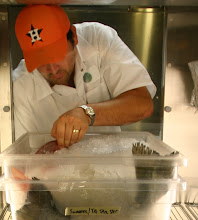

I’ve never put much stock in talent. It seems to me it’s always used when people talk of missed opportunities. I believe that hard work, tenacity, not being afraid of failure and a dedication to perfecting technique can surpass talent in any field of play.
Unique techniques that are specific to a region and micro-culture are hard to come by. In the Texas-Louisiana Gulf Coast region, Redfish on the Half-Shell surely fits that bill.
My first introduction to fish cookery was given to me by my grandfather, Olin “Swede” Caswell, with his technique for cooking Redfish.
Red Drum (Sciaenops ocellatus), Channel Bass, Red Fish, Spottail Seabass -- or just Reds -- are cousins to the Black Drum and have been known to interbreed. The coloring of Redfish changes due to its surroundings, ranging from bright copper to silver gray. Most have one spot on the upper quarter of the tail but multi-spotted fish are not uncommon.
Redfish range from the mid-Atlantic coast to the
Redfish have tremendous spawning potential with up to 1.5 million eggs per spawn which, on average, is every two days during their two month spawning period, from mid-August to mid-October. Their 20-40 million eggs per season coupled with their high growth rate and tolerance to fresh water is why Redfish are such a good candidate for aquaculture. Currently,

Redfish have also played a large part in politics. In 1977, fourteen concerned anglers got together and started the “Save the Redfish” campaign. The Redfish population was in need of help because of heavy commercial pressure, gill-netting and inadequate limits and enforcement of recreational fisherman. These anglers formed the Gulf Coast Conservation Association (GCCA) and, by 1985, their membership had spread to

Now, back to technique. Redfish on the Half-Shell has been a camp house staple up and down the coast all of my life and one that is very unique to this region. Redfish are a very hardy species with a very thick skin and scale structure.


The fish is filleted without skinning or scaling, then oiled and seasoned heavily on the flesh side. It is then placed on a hot grill - scales down - and that’s where it stays. The scales provide the perfect protection for the harsh flames.
The flesh side is basted frequently and covered during the process. This creates the perfect smoked/grilled/baked combination that results in one of the most distinguishable, and flavorful, fish techniques of all.
Redfish on the Half-Shell, Sauteed Gai Lan, Fried Mac & Cheese




3 comments:
I'm a long-time reader of your blog, which I found when looking up info before dining at Reef for the first time.
Coincidentally, I blogged about cooking reds on the half-shell at home just a couple of months ago. I just wrote an entry encouraging my folks to check out your much-more-expert version...
Thanks for another great post!
Gotta agree wit the Caz on this Technique vs. Talent thing...Seems like I had no talent at all when I started cooking, took a few years of work before any hope emerged. After alot of trial & error, people started to say "hey, you've got alot of talent". Thanks to Chef Caswell for finally clarifying this issue.
Having lived -- and eaten -- in HK and elsewhere in Asia for 10 years, I totally agree with the recommendation to cook there as part of a chef's education. And I am glad to see someone gets that what you can get from that experience is cooking technique, rather than "inspiration" to cook every future food item with some obscure Asian ingredient, fusion bent and/or Asian-ish title... People look at me like I am nuts when I say that the best food of any kind is found in HK -- probably the emphasis on that technique thing.
But where do you stand on the notion of cooking "with heart"?
Post a Comment